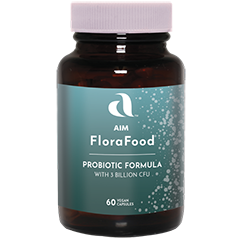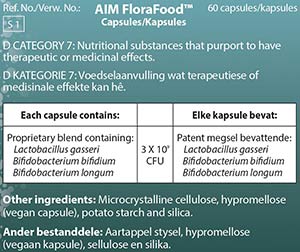AIM FloraFood ™
Probiotic blend of Lactobacillus gasseri, Bifidobacterium bifidum and Bifidobacterium longum.
FloraFood is a probiotic dietary supplement that delivers three billion good bacteria per capsule— Lactobacillus gasseri, Bifidobacterium bifidum and Bifidobacterium longum. 
How is FloraFood Unique?
- Ability to withstand stomach acid.
- Bacteria adhere to the intestinal wall.
- Distribution throughout the digestive tract.
- No refrigeration required.
Approach.
Bacteria thrive in our bodies. There are around 100 trillion bacteria in the digestive system, which is more than the number of cells in the body. The weight of these bacteria is about 4 lbs (1.8 kg).
Depending on the species, bacteria can be good or bad for your gut. When bad bacteria dominate, the effects include diarrhea, flatulence, bloating, intestinal toxicity, constipation and malabsorption of nutrients.
. A national survey of over 2,000 adults showed that 72 percent of Americans experience gastrointestinal discomfort of some kind multiple times a month, and most experience these issues for over 6 months. These health concerns result in time lost at work, school and play. They also appear to be occurring with much more frequency. While many digestive discomforts were almost unheard of decades ago, they are cropping up more frequently and in much younger people as well.
One way to help support digestive health is to be aware and take care of our intestinal flora— the trillions of bacteria that make the digestive tract their home. This includes maintaining the delicate balance between good and bad bacteria in your gut.
Good Bacteria (Probiotics)
Probiotics is the term used to describe the good bacteria in food or a dietary supplement that maintain or restore beneficial bacteria in the digestive tract.

- Supports the body’s microbiome.
- Maintains digestive health.
- Supplements good bacteria.
- Balances intestinal pH.
- Promotes balanced intestinal flora.
- Helps produce vitamins, especially B vitamins.
- May help maintain healthy cholesterol levels.
- Three billion live cells per capsule, guaranteed at the time of expiration.
What Do Good Bacteria Do for Us?
The Good bacteria in FloraFood provide us with powerful benefits:
- Aid in the digestive process by helping to digest lactose (milk sugar) and protein.
- Clean the intestinal tract, purify the colon and promote regular bowel movements.Create lactic acid, which balances intestinal pH.
- Protect us from environmental toxins, such as pesticides and pollutants, reduce toxic waste at the cellular level and stimulate the repair mechanism of cells.
- Support healthy immune response.
- Manufacture vitamins B6, B12, K, folic acid and assorted amino acids.
- May help maintain healthy cholesterol and triglyceride levels.
Lactobacilli.
Lactobacilli are one of the most important types of good bacteria found in the digestive tract, primarily in the small intestine.
Lactobacillus gasseri is one of the main species of lactobacilli that inhabit the human gastrointestinal tract. These bacteria are named lactobacilli because they turn lactose milk sugar into lactic acid. Lactobacilli can balance bacterial loads in the intestine because when they produce lactic acid, it alters the intestinal environment, making it unsuitable for some bad bacteria.
A parallel-group, double-blind, randomized, active-controlled clinical trial involving 169 people compared the effects of two combinations of probiotics on acute diarrhea. Lactobacillus gasseri combined with Bifidobacterium longum reduced the number of unformed stools by 80 percent during the first 2 days, showed a higher rate of individuals recovering fully and proved to shorten the duration and decrease the severity of diarrhea in adults when compared to mono-bacterium Enterococcus feacium.
When our gastrointestinal tracts are left void of good and bad bacteria, Lactobacillus gasseri is thought to offset this depletion by recolonizing the intestine to bring the microbiome to a balanced state.
Bifidobacteria.
Bifidobacteria are good bacteria, colonizing mainly the large intestine (colon) and contributing to regularity. Considered extremely important to the health of the gastrointestinal tract, bifidobacteria have been used to address digestive discomforts and boost the immune system. These strains are also important for the production of B vitamins.
Bifidobacteria may also reduce fluctuations in intestinal bacteria and the GI distress that can ensue
Bifidobacterium bifidum is especially good at enhancing the body’s immune response and limiting the increase of harmful enzymes.
Prebiotics (Fit ‘n Fiber) Feed Probiotics.
To help feed the three types of good bacteria found in FloraFood, AIM’s Fit ’n Fiber formula includes three types of prebiotic fiber: acacia, konjac (glucomannan) and guar gum. Each serving delivers 8 grams of prebiotic fiber to feed good bacteria, helping them to reproduce exponentially to ensure a balanced gut microbiome.
FAQs.
Who should use FloraFood?
Anyone concerned about digestive health should consider using FloraFood. Anyone exposed to stress could also benefit since stress upsets our digestive tract.
Does FloraFood need to be refrigerated?
Many probiotics require refrigeration, but the bacteria in FloraFood are stable at room temperature due to the unique, proprietary manufacturing methods. Therefore, FloraFood does not require refrigeration
Is there anyone who should not use FloraFood?
It is considered safe for everyone; however, diabetics using FloraFood should be monitored carefully because blood sugar levels may fluctuate and insulin intake may need to be regulated. When using dietary supplements, it is recommended that you consult your health care practitioner.
Side effects of FloraFood.
FloraFood is completely safe. However, some detoxification may occur. Please see our detoxification datasheet for more information. Pregnant and lactating women should always consult a health care practitioner when adding new supplements to their diets.
Can I take FloraFood with AIM PrepZymes® or other products?
Yes, you can take FloraFood with other AIM products. FloraFood and PrepZymes are both best taken with meals. However, PrepZymes will break down the bacteria in FloraFood, so take these products separately at alternate meals.
What is the source of the bacteria found in FloraFood?
All three strains of bacteria in FloraFood are cultured in a laboratory environment from good bacteria derived more than 30 years ago from a healthy human source.
How to Use FloraFood
- Take 1 capsule with meals twice daily.
- Keep out of reach of children.
- Take FloraFood and PrepZymes separately at alternate meals.
- Price and order information.
| USA | Australia | Canada | S.Africa | New Zealand | U.K. |
|---|
Want to learn more? See the FloraFood datasheet.
FloraFood Datasheet Download.
(82 kb pdf file)
Note: pdf files require the free Adobe Acrobat reader software. If its not on your PC you
can download it at http://www.adobe.com/products/acrobat/readstep2.html

